3 ways to end the misery of tech migrations
Safely migrate and modernize across cloud services, databases, and APIs.
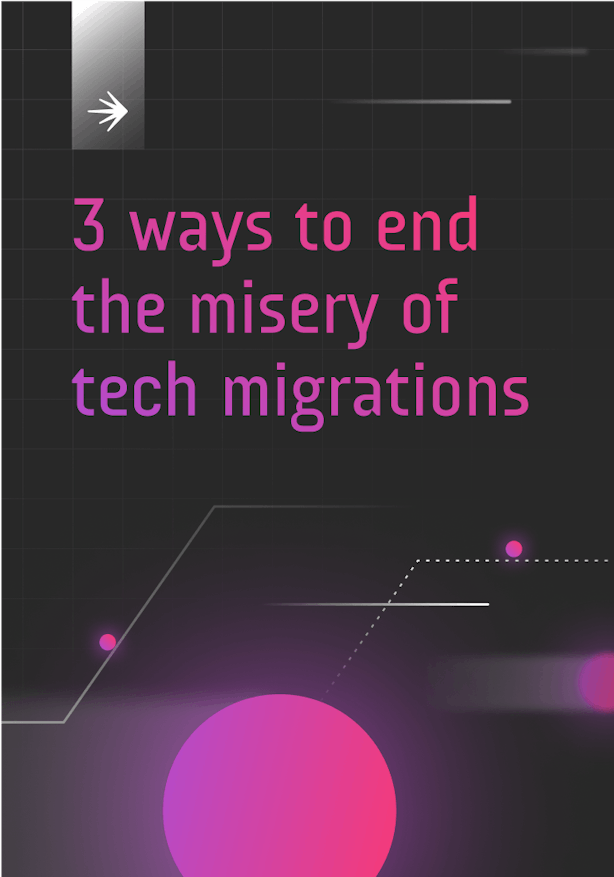
How LaunchDarkly can help
With LaunchDarkly, you can confidently migrate and modernize your tech stack without enduring repeated failures and chronic migraines. In this section, we will explore three chief benefits of LaunchDarkly that enable you to overcome the modernization challenges outlined above.
1. Avoid nightmare “big-bang” migrations
Migration projects are daunting and full of risk, and when tackled all at once, they often require maintenance windows in which businesses can’t operate. LaunchDarkly enables teams to mitigate those risks by introducing new infrastructure, databases, APIs, and other services in a progressive, controlled way to avoid outages and maintenance windows. By approaching technology migrations in digestible chunks, you reduce the likelihood of disaster.
Break migrations into manageable pieces
Migrating to a cloud provider like AWS sounds like one big project, but it actually involves moving a lot of pieces, such as infrastructure, databases, and services. Flicking the switch on all of those at once is both intimidating and risky. LaunchDarkly enables you to isolate the different pieces, so you can introduce new infrastructure, databases, APIs, and other services gradually to avoid outages and maintenance windows.
With LaunchDarkly feature flags, you can treat a specific back-end service like a feature. Let's imagine you're migrating infrastructure, and it involves multiple back-end services: databases, APIs, etc. You can wrap a new database in a feature flag and gradually route traffic away from the legacy database to the new system—in the same way you would with a feature. And you can do the same with APIs and other back-end services.
Atomizing the migration in this way reduces risk.
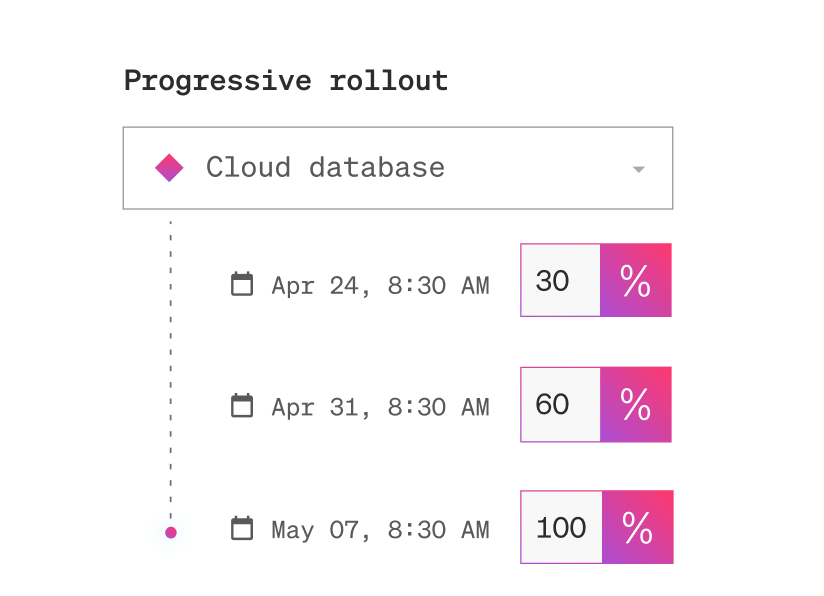
Feature flags
Feature flags are a software development process used to enable or disable functionality remotely without deploying code. With feature flags, you can deploy changes to a production environment without making them visible to users (i.e., decouple deploy from release). This reduces risk when shipping software changes, whether those changes are front-end features or back-end components.
When code deployments and releases (i.e., code changes that are accessible to end-users) are decoupled, enterprises have more control over the migration of large and highly complex systems. Teams can push code into production to release new systems, while gradually shifting users off the legacy platform.
Watch: Use Feature Flags to Avoid Downtime During Migrations
Go beyond infrastructure routing
Control migrations at the application layer to flexibly target any parameters. Let's look at a concrete example. Imagine a scenario in which developers want to incrementally roll out a new cloud database system by region: starting with the U.S., then moving to Europe, then to Asia, and so on. If they rely exclusively on infrastructure tools such as a load balancer to perform that action, it could needlessly prolong the process. Developers may end up submitting a ticket to the IT operations team every time they need to add a destination to the load balancer or increase the percentage of traffic to the new database. And developers lose control over the migration in the process.
A better alternative is to use flags alongside your infrastructure tools. In this example, a developer could submit a single ticket to enable an open connection between their API/front-end and the new database system. Then, the developer(s) could alter the traffic-routing rules themselves with feature flags. And, of course, as with any feature-flagged change, if during one stage of the migration, latency increases or error rates surge, they could instantly revert back to the previous stage—one in which operational health was stable.
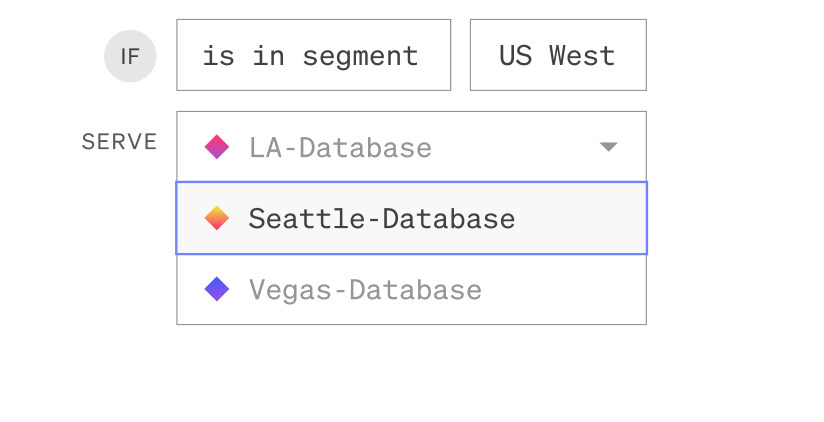
Segment experiences
Use sophisticated targeting rules to expose certain back-end services to specific user segments based on business needs. With LaunchDarkly's custom contexts, you can experiment and conduct staggered migrations based on parameters that map to your business needs.
You can enable a new API for just internal developers for testing, while disabling it for everyone else. Or you can route certain types of web requests to a new cloud database while routing other requests to your legacy system. Or you can enable your new cloud infrastructure for users on Windows operating systems while supporting other operating systems with your on-premises data center.
LaunchDarkly targeting gives you virtually unlimited flexibility, ensuring your migration meets your business requirements perfectly.
Custom contexts
Custom contexts are a capability in LaunchDarkly that enables you to define, experiment, and target based on your data model, business language, or release process. So, instead of only being able to target users, with custom contexts you have almost endless flexibility to deliver to any kind of thing and as many kinds of things as you like, all at once. For example, you can enable a new back-end service for only users in Philadelphia, on iPads, whose mother’s maiden name is Stallone. Everyone else gets your legacy infrastructure.
Watch: Migrating to Custom Contexts

Example
Progressive rollouts give you control and flexibility while migrating
You have a three-tier application composed of a front-end, API, and database. You're migrating to a new API to address some performance concerns with the existing one, so for some time, your front-end may be communicating with two APIs at once. If you rely on traffic rules to enable testing of the new API, your users are going to be impacted if something goes wrong. Instead, you could use a feature flag and targeting rules to route some percentage of traffic to the new API—if something goes wrong, you can immediately flip the flag to direct traffic to the working API. If all goes well, you might roll out a new, cloud-based database, progressively migrating workloads for the new API to your new cloud database.
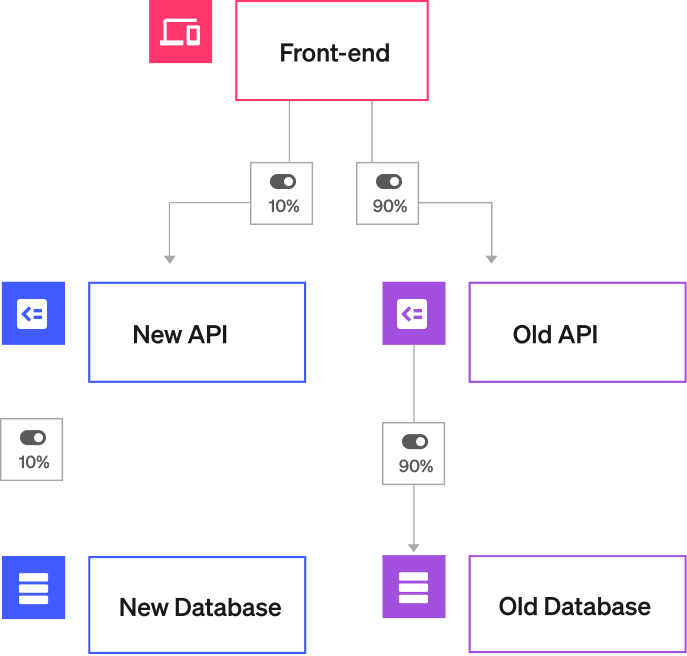
2. Validate performance across each step of a migration.
Instead of having to roll out new back-end components all at once and wait for frustrated customers to alert you to an error, LaunchDarkly provides full visibility and governance around critical changes to keep your teams aligned and your business, and data, safe.
Progressively release new services
So, you've broken your migration down into less risky parts. Now, you can introduce new back-end components to users incrementally to limit the blast radius of potential errors. You can also put guardrails in place to prevent unintended consequences by leveraging LaunchDarkly Approvals. This gives more team members the chance to provide input on planned changes to a flag.
Here’s what it might look like, for example, to use feature flags to gradually roll out a new database. At the start of the migration, you can route 100% of ‘read’ and ‘write’ events to the old database, while duplicating 10% of the write events and then pushing them to the new database. As you monitor performance and see that your system has remained stable, you can then move to the next phase of the rollout, until 100% of events are funneled to the new system.
Similarly, you could progressively deliver a new API or some other service by device type, geolocation, or any other attribute you can imagine. You could start with web browsers, then gradually expand to iOS devices, then to Android devices, then to gaming consoles, and so on. And you could do so at your own pace.
These are great first steps, but once your migration is under way, how do you monitor and measure how the migration is progressing? How do you know that it's having the intended impact?
Connect innovation to business value
If you're migrating to a new service or database, you should be able to measure how those changes impact app performance and business metrics, and adjust accordingly.
With LaunchDarkly, you can create back-end experiments to collect data on which version of your application has the desired impact. Whether you're looking to improve page load times, reduce server costs, or increase revenue, you can measure the effect of your change and immediately ship the best variation to your audience.
As an example, operations and platform engineering teams can use LaunchDarkly to create a back-end experiment that measures the impact of a new API on infrastructure costs (from AWS, Microsoft Azure, etc.) They can measure the costs against a baseline and tweak the API implementation until the costs fall to a reasonable level. In this case, they will have migrated to a new API while driving operation costs down, thus benefiting the business on two fronts.
Read: How to Enable Server Side Experimentation
Monitor via APM tools
Sometimes, even the most sensible and controlled migrations don't go as planned. The key in these instances is to have visibility: first you need to know that something isn't working, you need to isolate the cause of the error, and then immediately mitigate the impact. By integrating LaunchDarkly with an application performance monitoring (APM) tool, you can quickly uncover changes or issues caused by a migration.
Watch: LaunchDarkly and Datadog
Example
Datadog + LaunchDarkly make troubleshooting easy
Let's say one of your developers just initiated part of a migration and is controlling it with a feature flag. Suddenly, error rates are surging, but you're ready for it because with the LaunchDarkly and Datadog Events integration, a) your ops team can see the spike on their Datadog dashboard and b) the team can quickly correlate the error with the developer's feature flag, which had recently been activated. Now, resolution is as simple as shutting off the flag tied to the back-end change that caused the error, so the team can debug without impacting customers.
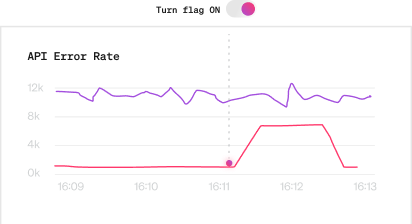
3. Recover faster from failure
Your customers never have to feel the impact of migration errors. With LaunchDarkly's enhanced recovery capabilities like automatic flag triggers and kill switches, you can recover from any errors in near-real time without your customers ever knowing.
Revert to safety instantly
In the event of an error or performance issue during a migration, teams can perform a controlled fail-over back to the original service or infrastructure within milliseconds by using a feature flag as a kill switch. As in the example above, if part of a migration causes an issue, simply toggling the flag off again is enough to restore service to normal, without having to roll back or deploy new code.
Feature flags allow you to deactivate a broken or problematic service in runtime. For example, imagine you’ve successfully routed 25% of all web traffic to a new API. But when you expand to 50%, it causes your website to malfunction. If you’re using a flag to govern the rollout, you could disable the flag and instantly return to the stage in which only 25% of traffic hit the new API. Or out of an abundance of caution, you could turn the API off entirely. The key point here is that you can resolve this error without manually re-routing traffic by updating the destination or weights on a load balancer. Instead, you revert the flag to a stable API with the flip of a switch.
Empower more teams to resolve incidents
Another advantage of not having to deploy code to remediate migration issues is that you can enable more team members to resolve incidents in real- time. LaunchDarkly's custom roles allow you to define permissions for feature flags, projects, environments, metrics, and teams.
With the right access controls in place, dev teams can toggle broken functionality off without waiting for others to respond or having to run a change request through a cumbersome approval process. Additionally, your SRE or support engineering team is empowered to remediate incidents without having to wait for the relevant developer to be paged to address the root cause.
Rather than calling someone at three o'clock in the morning, we'll just shut the flag off. We'll figure it out in the morning, please stay asleep.
Justin Duhatschek
Progressive Delivery Manager at KBX Technology Solutions
Automate remediation
Beyond human intervention, the next level of risk mitigation for migrations is automation. LaunchDarkly's integrations with popular APM providers mean that you can set error rate thresholds and leverage feature flags as migration circuit breakers (flag triggers) to instantly recover when the threshold is exceeded.
Example
Automate error remediation with APM flag triggers
As before, when migrating a back-end component of your app, you can wrap it in a feature flag to track its performance and behavior, and use a flag trigger to connect the feature flag to a performance metric.
A flag trigger is composed of an unguessable URL that LaunchDarkly assigns to you. Accessing one of these URLs either turns the flag on or off. You can connect these URLs to an alert in your APM, observability, logging, or error tracking tool, or any other tool which can fire webhooks.
When a flag trigger is connected to one of your tools and the performance of, say, your new algorithm crosses a predefined threshold, your tool triggers an alert that hits the URL and turns the feature flag off (so no one has to get paged to hit the button).













